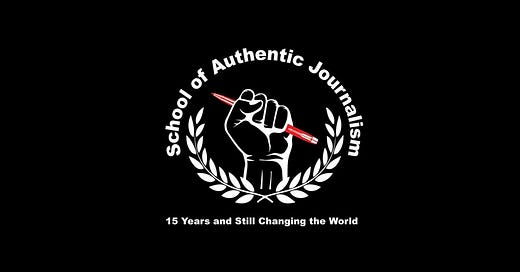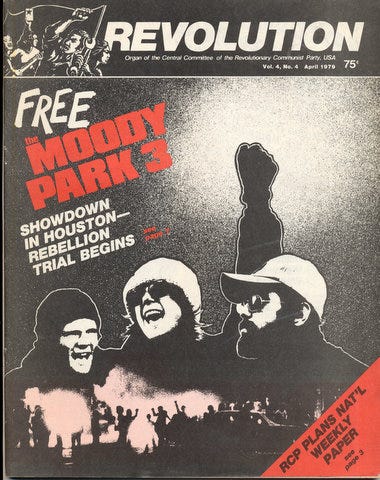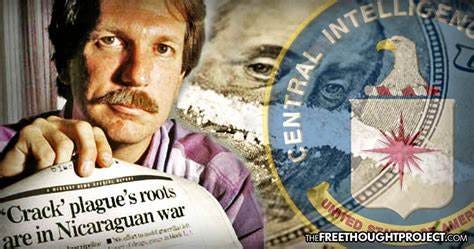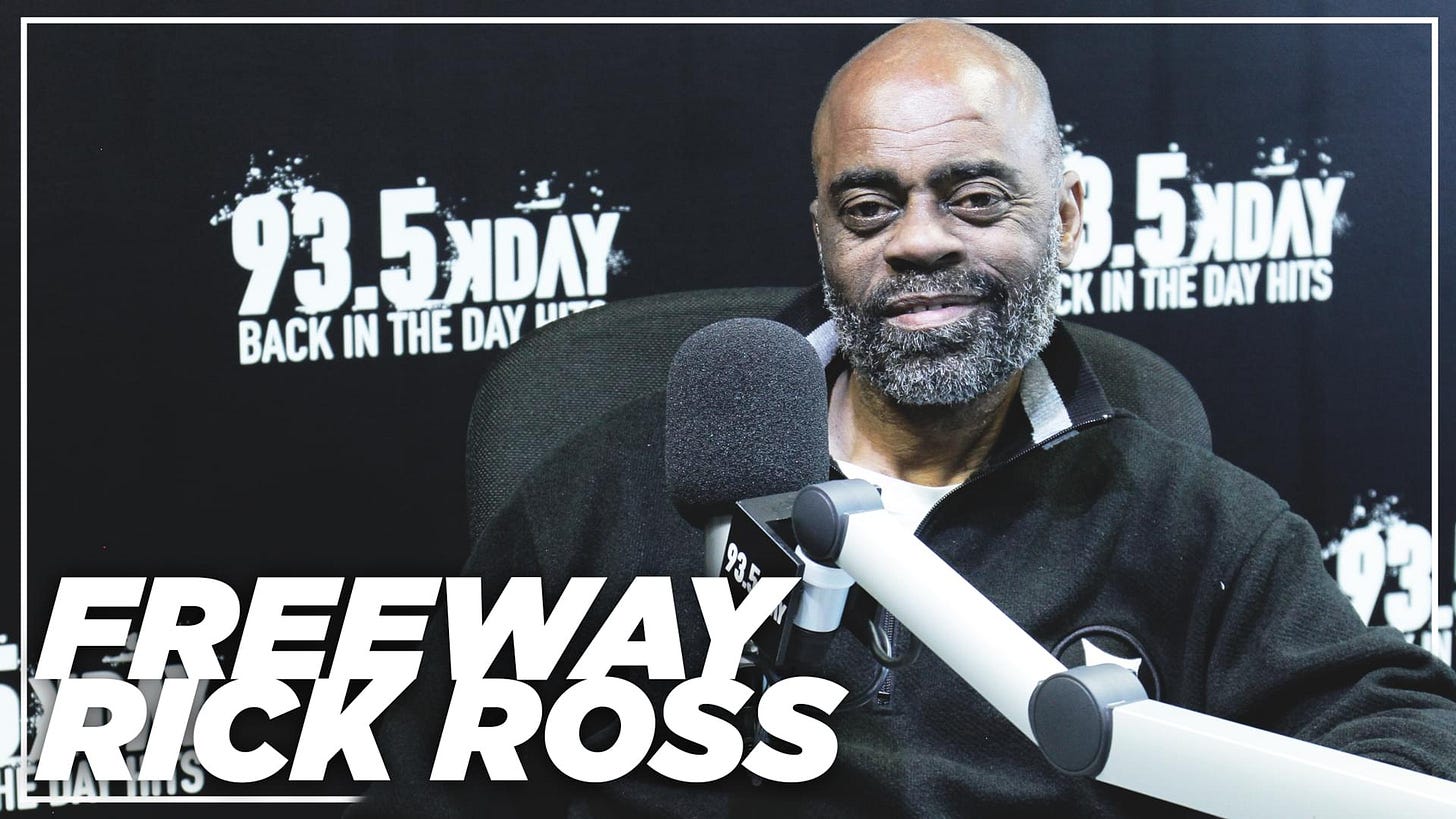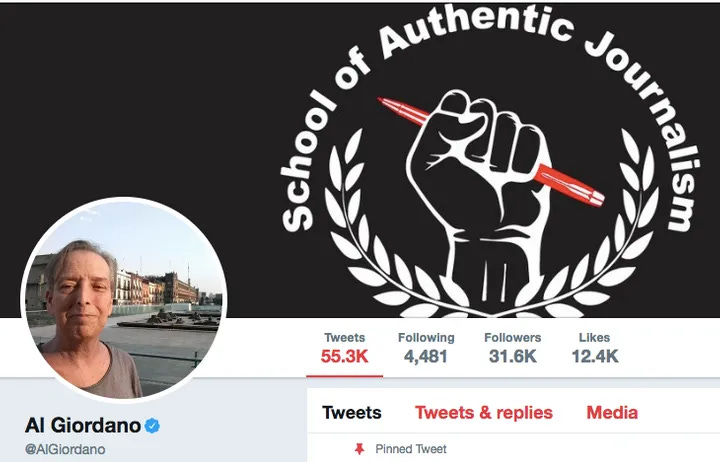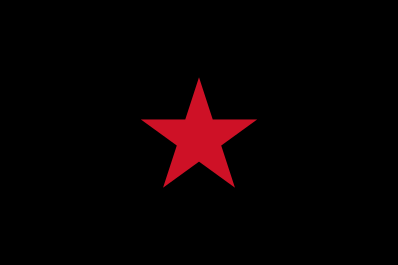Gary Webb's "Dark Alliance" a Distraction from Soviets Targeting Americans with Drugs?
Gary Webb joined Marxist Al Giordano's Narco News Bulletin and taught at his School of Authentic Journalism in Mexico. Giordano works with the Zapatista Army of National Liberation.
“A journalist is, and must be, a revolutionary” the 48-year-old Webb told the 26 Authentic Journalism Scholars and their professors on that rooftop over the Caribbean Sea.
Gary Webb was giving interviews to the Revolutionary Worker. https://revcom.us/en/a/v19/910-19/913/webb.htm
The Revolutionary Worker Newspaper was the weekly voice of the Revolutionary Communist Party, USA.1
‘Drugs are considered to be the best way to destroy the United States. By undermining the will of American youth, the enemy is destroyed without firing one bullet'. MAJOR JUAN RODRIGUEZ, Cuban intelligence officer, citing and invoking Antonio Gramsci, Lavrentii Beria and Sun-Tzu in a single sentence, 1988. (Sun-Tzu: the ancient Chinese military deception strategist)
'Drugs are used as political weapons. The target was the youth...'. ANTONIO FARACH, high-level Nicaraguan official, 1984.
'I was ordered to load up the United States with drugs'. MARIO ESTEVEZ GONZALEZ, Cuban intelligence agent, 1981.
'Deception and drugs are our first two strategic echelons in the war...'. NIKITA KHRUSHCHEV, 1963
'We will disarm the capitalists with the things they like to taste'. CHOU EN-LAI, 1958
Gary Webb is best known for his book "Dark Alliance”, which originally appeared as a series in The Mercury News in 1996. With what we now know about the Soviets using Cuban DGI to infiltrate and direct Latin America drug trafficking we need to reevalute Webb’s claims.
Critics have long viewed the series' claims as inaccurate or overstated, so let’s investigate these claims ourselves.
Wikipedia:
The first article set out the series' basic claims: "For the better part of a decade, a San Francisco Bay Area drug ring sold tons of cocaine to the Crips and Bloods street gangs of Los Angeles and funneled millions in drug profits to a Latin American guerrilla army run by the U.S. Central Intelligence Agency." This drug ring "opened the first pipeline between Colombia's cocaine cartels and the black neighborhoods of Los Angeles" and, as a result, "The cocaine that flooded in helped spark a crack explosion in urban America.
The series focused on three men: Ricky Ross, Oscar Danilo Blandón, and Norwin Meneses. Ross was drug dealer in Los Angeles. Nicaraguan Blandón and Meneses smuggled drugs into the U.S. and supplied dealers.
Primarily focused on Blandón and Meneses relationship with the Contras and CIA.
It highlighted the failure of law enforcement to prosecute them and stated that this was largely due to their Contra and CIA connections.
The second article described Blandón's background and how he began smuggling cocaine to support the Contras. Meneses, an established smuggler and a Contra supporter as well, taught Blandón how to smuggle and provided him with cocaine.
It claims Ross discovered the market for crack in Los Angeles, he began buying cocaine from Blandón.
Blandón and Meneses' supply of low-priced high-purity cocaine "allowed Ross to sew up the Los Angeles market and move on.
“Ross contradicted his own assertion that Blandon made him a successful crack dealer. Ross admitted that he first started selling crack in 1979 -years before he met Blandon- and rapidly expanded his business by emphasizing volume sales and offering prices that undercut his competitors. Confirming the contents of a 1994 interview with the Los Angeles Times, Ross said he felt that God "put me down to be the cocaine man"; that lengthy autobiographical account by Ross makes no mention of Blandon or any other Nicaraguans.”2
The third article discussed the social effects of the crack trade, noting that it had a disparate effect on African-Americans. Asking why crack became so prevalent in the Black community of Los Angeles, the article credited Blandón, referring to him as "the Johnny Appleseed of crack in California."
Found disparities in the treatment of Black and White traffickers in the justice system, contrasting the treatment of Blandón and Ross.
Blandón cooperated with the DEA, so he spent only 28 months in prison. He became a paid government informant, and received permanent resident status.
Ross was released early after cooperating in an investigation on police corruption, but was rearrested a few months later with Blandón's help. It was suggested this was in retribution for Ross' testimony in the corruption case.
While it was absolutely true that that there were racial disparities against crack and cocaine convictions. The Black Congressional Caucus also had a hand in supporting higher punishment for crack convictions because it was ravaging the Black community.
"So many different individuals and operations were involved in the initial spread of crack that you could eliminate any one person or group from the picture and be certain that the outcome would have been the same," said Jonathan Caulkins, a professor of public policy at Carnegie Mellon University, who has conducted extensive research on the dynamics of cocaine trafficking.3
CIA Crack Epidemic Myth
Blandon’s testimony and drug enforcement estimates show that Blandon distributed about five tons of cocaine over a decade-long period. Although this is a lot of cocaine, it’s only a tiny fraction of the amount that was trafficked to the United States. According to academic estimates, more than 250 tons of cocaine were distributed annually throughout the United States…
According to a 1996 article by the Washington Post, “Available data from arrest records, hospitals, drug treatment centers, and drug user surveys point to the rise of crack as a broad-based phenomenon driven in numerous places by players of different nationalities, races, and ethnic groups.”
The article continued, “Although Nicaraguans took part in the drug trade of that era, most of the cocaine trade can be attributed to Colombian and Mexican smugglers, and distributors within the United States including Jamaicans, Dominicans, Haitians, and Americans of varying backgrounds, according to widely accepted evidence from government reports and academic studies.” (Roberto Suro and Walter Pincus, CIA and Crack: Evidence Is Lacking Of Alleged Plot. Washington Post, October 4, 1996, Page A01)
Another major contradiction is that Blandon no longer had ties with the contras when he met Rick Ross. Blandon law enforcement records show that Blandon didn’t start distributing to Ross until 1983 or 1984, by which time he was no longer associated with his supplier, Meneses, and had stopped sending funds to the contras.
Blandon also stated that Ross was already “a big coke dealer” before they connected. He claimed that Ross was able to instantly start buying several kilos of cocaine per day from him. Blandon said that Ross had several supply sources and was obtaining large quantities of cocaine from many drug dealers.
Lastly, Blandon denied ever having connections with the CIA. Blandon became an informant for the Drug Enforcement Administration (DEA), where he denied being involved with the CIA. This was confirmed by federal law enforcement officials and by court filings by federal prosecutors.4
Regardless of how they were crafted, the Mercury News articles would not have generated so much interest if the allegations had not fallen on fertile ground. The contras have been associated with intrigue since the Iran-contra affair rocked the Reagan administration in late 1986 with the news that weapons were sold to Iran to help free hostages from Beirut, and the proceeds ended up helping finance the contras. And since the earliest days of the Cold War, the CIA has faced accusations that it tolerated drug trafficking by groups it supported, because it considered communism a greater evil.
All of these strands came together once before. Following a two-year investigation, a Senate Foreign Relations subcommittee concluded in a 1989 report that the turmoil created by the Nicaraguan civil war was "exploited easily by a variety of mercenaries, pilots and cartel members involved in drug smuggling." In some cases the committee found that drug smugglers were hired to move contra supplies and that "individual contras accepted weapons, money and equipment from drug smugglers." Although it did not reach definitive conclusions about CIA involvement, the committee report stated, "There are serious questions as to whether or not U.S. officials involved in Central America failed to address the drug issue for fear of jeopardizing the war effort against Nicaragua." Asked how the latest allegations squared with these findings, the subcommittee chairman, Sen. John F. Kerry (D-Mass.), said, "There is no question in my mind that people affiliated with, on the payroll of and carrying the credentials of the CIA were involved in drug trafficking while involved in support of the contras, but it is also important to note that we never found any evidence to suggest that these traffickers ever targeted any one geographic area or population group."5
Cheap Cocaine wasn’t the result of glut, but Revolutionaries in Cuba and Latin America purposely kept it cheap to destroy the west. Minorities were deemed expendable as Lumpen Proletariats.
The use of “crack” had become an epidemic by 1989. Why did we not take more action? Politics came into play. Our elected officials were protecting “détente” or “peaceful co-existence,” with the Soviet Union. All the while, they were at war with the United States.
Millions of Americans, including our children, were exposed to the debilitating effects of drugs in order to keep up the pretense with the Soviet Union. The question is did undercover Soviet agents played a helpful role?
Drugs are a Strategic Weapon by Adm. James A. Lyons Oct 07, 2018
While it is generally accepted that illicit drugs are linked to crime families, organized crime, and terrorism, President Trump said, “It’s vital for public health and national security that we fight drug addiction and stop all forms of trafficking and smuggling that provide the financial lifeblood for vicious trans-national cartels.” He is spot on!
We have known for years the drug problem goes much deeper than the trans-national cartels. Its genesis has a focused strategic dimension that goes back decades. Dr. Joseph D. Douglass, Jr, in his well-researched book, “Red Cocaine,” discusses in detail how our historical enemies, primarily Beijing and Moscow, made it official state policy to use drugs as a form of political warfare to bring about the decay and destruction of Western societies, particularly the United States…
As Dr. Douglass points out, the Chinese were ahead of the Soviets in trafficking drugs as a tool in their political warfare arsenal. In the 1950s and 1960s, the most important official exercising day-to-day control over Chinese narcotics operations was none other than Premier Chou En-lai. According to Dr. Douglass, his strategy was quite simple; “to disarm the capitalists with the thing they like to taste (drugs).” While the production and distribution of drugs was a valuable source of income and a “powerful weapon of subversion,” the main target was to destroy the morale of the U.S. military fighting in Southeast Asia.
While the Chinese initiated the use of drugs as political and strategic warfare, it was the Soviets who made drug trafficking the effective strategic warfare it has become. As I have previously noted, the potential physically-debilitating effects of drugs on the military captured the imagination of former Soviet Premier Nikita Khrushchev as a way to weaken and destroy both militaries and societies, with America as the main target. Their plan was to institute a long-range strategic operation to affect several generations. Russian President Vladimir Putin certainly has not overlooked this strategic weapon, with Russia’s deep roots in Cuba and throughout Latin America.
The Soviet strategy included how to penetrate organized crime, not to take over the cartels, but more to control the flow of drugs as well as identifying which officials could be corrupted. The two-pronged attack consisted of drugs poured into our societies and terrorism to destabilize the country.6
Who is Gary Webb and why would he exagerate the role of the CIA in the Crack epidemic?
Narco News: Gary Webb Joins Narco News as Guest Editor By Al Giordano March 3, 2003
ISLA MUJERES, MEXICO; FEBRUARY 20, 2003: On the rooftop of the tallest building on the Caribbean Isle of Women, the Narco News cane of leadership was passed last Thursday to Authentic Journalist Gary Webb.
Gary Webb, the man who broke the back of drug war simulation by exposing the complicity of the U.S. government with drug trafficking in his series Dark Alliance: The CIA, the Contras and the Crack Cocaine Explosion, will be taking over my editorial duties at Narco News, beginning immediately, through April 15th.
Journalist as Revolutionary
“A journalist,” the 48-year-old Webb told the 26 Authentic Journalism Scholars and their professors on that rooftop over the Caribbean Sea, “is, and must be, a revolutionary.”
Full Disclosure: The author wishes to acknowledge the material assistance, encouragement, and guidance, of The Narco News Bulletin, The Narco News School of Authentic Journalism, publisher Al Giordano and the rest of the faculty, and of the Tides Foundation. Narco News is a co-sponsor and funder of the international drug legalization summit, “OUT FROM THE SHADOWS: Ending Prohibition in the 21st Century,” in Mérida, Yucatán, and is wholly responsible for the School of Authentic Journalism whose philosophy and methodology were employed in the creation of this report. The writing, the opinions expressed, and the conclusions reached, if any, are solely those of the author.7
According to Wikipedia:
Al Giordano (born December 31, 1959) is an American journalist, political commentator, and former anti-nuclear and environmental activist and organizer.
He became involved in the antinuclear movement in New York State and New England at the age of 16, engaging in protests and demonstrations with the Clamshell Alliance and other groups, and founding and organizing the Rowe Nuclear Conversion Campaign, a group protesting the continued of the Yankee Rowe Nuclear Power Station in Rowe, Massachusetts. The plant was shut down in 1992.
In 1997, Giordano spent four months in Chiapas, Mexico, intending to join the Zapatista Army of National Liberation. The rebels, however, insisted that Giordano could serve them best as a journalist. As a result, Giordano started his own online periodical, The Narco News Bulletin…
EZLN is a far-left political and militant group that controls a substantial amount of territory in Chiapas, Maexico. Its ideology has been characterized as libertarian socialist, anarchist, Marxist, and having roots in liberation theology.
Gary Webb isn’t who we thought he was. Why is Gary Webb hanging out with commies who are accused of sexual assault? He’s giving interviews to a Communist Party U.S.A. affiliated newspaper.
It’s time to rethink everything.
-D.C.
Additional Articles:
We Probed Sexual Misconduct Claims Against Journalist Al Giordano. Here's What We Found.
Veteran journalist and liberal activist Al Giordano sexually harassed at least three younger women who attended his School of Authentic Journalism and threatened to cut off people who crossed him from the school’s community, four women and one man who attended the school told HuffPost.
But it’s his School of Authentic Journalism, which Giordano created in 2002 to teach others how to cover social movements, that lies at the heart of the misconduct allegations.
Once a year, if his fundraising efforts net sufficient money, Giordano has invited about 20 applicants to attend a journalism training course in Mexico.
The sessions have historically run from a week to two weeks, during which time students learn about “clear writing, compelling camera and microphone work, scripting video to go ‘viral,’ navigating the rowdy Wild West frontier of the Internet, effective investigation, public speaking and so much more,” according to a March 9, 2017, plea for funding. The majority of the alumni who spoke to HuffPost, both on and off the record, were in their early to mid-20s when they attended the school. And the professional contacts made there carry forward: Alumni describe a community that was kept active through Facebook groups that Giordano controlled.
In February, Martha Pskowski, an independent journalist based in Mexico City, began to offer a darker portrait of the school.
Isadora Bonilla, 33, attended Giordano’s school in 2012. That April, he approached her to offer her a job as an administrator for Narco News.
She soon discovered that the position was more like being Giordano’s personal assistant than serving as the administrator of a news site. One of her tasks was to recruit her friends to join Giordano for informal “strategy sessions” on journalism and activism at his home in Mexico City. Giordano “tried to sleep with all the women,” she said.
Paper: No Crack Conspiracy -- Probe Finds Market Forces, Many Dealers - Not U.S. Plot by Jesse Katz, Claire Spiegel, Ralph Frammolino Oct 20, 1996
Although it's unclear what, if anything, the U.S. government might have known about this trade, a few truths are clear: Cocaine was flowing from Colombia into Los Angeles long before the Nicaraguan traffickers arrived on the scene - Oscar Danilo Blandon, the Nicaragua ring's Los Angeles point man, was not "the Johnny Appleseed of crack in California," as the San Jose Mercury News contended in a report in late August. South Central drug dealers produced it, not Latin American middlemen.
The South Central Los Angeles dealer named "Freeway" Ricky Ross, who purportedly was the sole conduit of cocaine from Nicaragua to the Bloods and Crips gangs, was determined to rise to the highest echelons of the drug world, with or without the help of his Nicaraguan sources. According to interviews and court testimony, he was an established crack retailer before meeting Blandon in 1983 or 1984, at which time the Nicaraguan said his tenuous links to the anti-Sandinista resistance already had been severed.
Rather, the rise of crack was driven by a broad array of factors - a worldwide glut of powder cocaine, shifting tastes among addicts, and the entrepreneurial moxie of the inner-city hustlers who marketed it.
Crack was breaking out everywhere - New York, Washington, D.C., Miami and Los Angeles - at almost exactly the same time in the early 1980s.
Although Ross was a dominant figure on the Los Angeles scene, he still had to jostle with the likes of Thomas "Tootie" Reese, Wayne "Honcho" Day, Elrader "Ray Ray" Browning and the Bryant family - all drug lords of the late '70s and early '80s who came on the scene before Ross or at the same time.
Ross was still big enough that Los Angeles authorities in 1986 formed the "Freeway Rick Task Force," which contributed to his reputation as crack's leading entrepreneur. But even members of that squad acknowledge they could have picked any number of targets.
Critics and commentators would later debate whether the Mercury News articles in fact accused the United States government of being responsible for the nation's crack cocaine epidemic. In an October 2, 1996, Washington Post article, Gary Webb, the reporter who wrote the Dark Alliance series, asserted that the article had not claimed that the CIA knew about Blandon's drug trafficking. The Washington Post article quoted Webb as saying, "We've never pretended otherwise . . . This doesn't prove the CIA targeted black communities. It doesn't say this was ordered by the CIA.. . . Essentially, our trail stopped at the door of the CIA. They wouldn't return my phone calls." Webb would say as late as June 22, 1997, in an interview with The Revolutionary Worker, "We had The Washington Post claim that the stories were insinuating that the CIA had targeted Black America. It's been a very subtle disinformation campaign to try to tell people that these stories don't say what they say. Or that they say something else, other than what we said. So people can say, well, there's no evidence of this, you know . . . You say, well, this story doesn't prove that top CIA officials knew about it. Well, since the stories never said they did, of course they don't."
USDOJ/OIG Special Report: THE CIA-CONTRA-CRACK COCAINE CONTROVERSY:
A REVIEW OF THE JUSTICE DEPARTMENT’S INVESTIGATIONS AND PROSECUTIONS
(December, 1997)
Drug dealer benefited from agencies' strife by Seth Rosenfeld Aug. 16, 1998
But the report last month concluded Meneses had no CIA connection and made only modest contributions to the contras. The failure to prosecute him was a result not of federal intervention on his behalf but of long-standing problems in federal anti-drug efforts.

